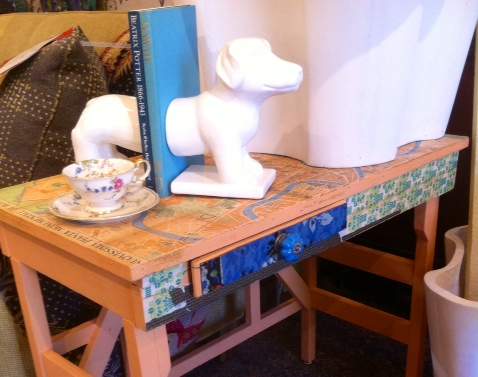How to refinish with new, quirky ideas...
28 October 2013
Pieces from the past can be refreshed to suit your present esthetic. Take a cue from Chris Meredith, owner of Your Nesting Place in Milford, who carries old and new home decor in her store.Her personal restoration skills have evolved through the years. “I used to slap on a coat of paint and maybe make it crazy with a two-tone and then be done,” she says. “The part that hasn’t changed is the sources, like estate sales, antique markets and flea markets.”
Now, she’s exploring heavy distressing, vintage wallpaper, unique hardware and more. Meredith has also advanced to enhancing objects with architectural accents such as vintage molding and tin, and covering case goods with painted canvases. She recently painted an old vanity in a pale shade of pink before covering parts of it with a pink flamingo painting for a completely unique effect. “I just happened to have a painted canvas,” she says. “It wasn’t old, but it doesn’t matter if it has the right look.”
For more interest, she ran the canvas asymmetrically. “I always think, ‘What’s the obvious way to apply something and then how am I going to do it?’ ” she says. On the top of a kitchen cabinet turned bookcase, she attached an old U.S. mail sack that adds character. Meredith likes to leave some of the original wear and tear. “It’s not about being perfect,” she says. “I call them ‘love bites.’ They’re part of its story.”
Besides, she says, “If you want perfection, buy new.”
A dated end table with a round profile was given new life when she replaced the lattice inserts with vintage tin, which is no easy task. Fresh paint gave it a whole new feel. “Now it’s much more chic,” Meredith says.
 Another redo was a quirky little desk with an off-center drawer. She covered the top with a vintage map, the drawer with vinyl flooring from the ’40s and the front with vintage wrapping paper. The knob is from Anthropologie.
Another redo was a quirky little desk with an off-center drawer. She covered the top with a vintage map, the drawer with vinyl flooring from the ’40s and the front with vintage wrapping paper. The knob is from Anthropologie.The distinctive desk retails for $148. “I try to keep the prices reasonable,” she says.
Creating a new look for each piece is a process. In addition, she says you need a stash of stuff that takes time to accumulate.
“Don’t overthink it,” she says. “Who cares if you make a mistake? You only have to please yourself.”
“It’s really trial and error until you train your eye to what works for you,” says Meredith, who recommends spray paint for Victorian and Jacobean pieces with lots of curves.
Her other projects include covering lampshades with mesh, fabric, even chicken wire, and embellishing bland bookcases with molding or corbels for architectural interest.
Still, the piece needs to have potential from the start. “If it doesn’t have good lines to begin with, it isn’t going to be fashionable,” she says.
Lastly, not everything you do has to match. “Sometimes the ones that don’t match at all turn out the best,” Meredith says.
More news from Remland Carpets